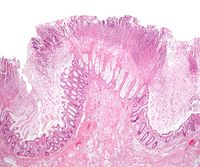Difference between revisions of "Clostridium difficile"
Jump to navigation
Jump to search
| (9 intermediate revisions by 2 users not shown) | |||
| Line 1: | Line 1: | ||
| − | + | ''Clostridium difficle'' is a gram positive bacteria of the family ''Clostridiaceae''. They are normally part of the normal flora, so known as a commensal bacteria. The problem arises when the bacteria competing within the host are destroyed by antibiotics. | |
| + | |||
[[Image:Clostridium difficile.jpg|200px|thumb|right|'''Clostridium difficile''' (Author: Nephron, Wikimedia Commons)]] | [[Image:Clostridium difficile.jpg|200px|thumb|right|'''Clostridium difficile''' (Author: Nephron, Wikimedia Commons)]] | ||
| − | |||
| − | |||
''C. difficle'' become overpopulated, and begin to produce pathogenic strains producing toxins, namely enterotoxin and cytotoxin. These may cause [[diarrhoea]], and abdominal pains, or pseudomembranous colitis (PMC) under more severe circumstances. | ''C. difficle'' become overpopulated, and begin to produce pathogenic strains producing toxins, namely enterotoxin and cytotoxin. These may cause [[diarrhoea]], and abdominal pains, or pseudomembranous colitis (PMC) under more severe circumstances. | ||
| Line 8: | Line 7: | ||
It is a motile bacteria, showing optimal growth on blood agar. | It is a motile bacteria, showing optimal growth on blood agar. | ||
| − | |||
| − | |||
| − | |||
| − | |||
| − | |||
| − | |||
| − | |||
| − | |||
| − | |||
| − | |||
| − | |||
| − | |||
| − | |||
| − | |||
| − | [[Category: | + | [[Category:Clostridium_species]][[Category:Dog]][[Category:Horse]] |
| + | [[Category:To_Do_-_Max]] | ||
Revision as of 09:12, 27 July 2010
Clostridium difficle is a gram positive bacteria of the family Clostridiaceae. They are normally part of the normal flora, so known as a commensal bacteria. The problem arises when the bacteria competing within the host are destroyed by antibiotics.
C. difficle become overpopulated, and begin to produce pathogenic strains producing toxins, namely enterotoxin and cytotoxin. These may cause diarrhoea, and abdominal pains, or pseudomembranous colitis (PMC) under more severe circumstances.
It is a motile bacteria, showing optimal growth on blood agar.
